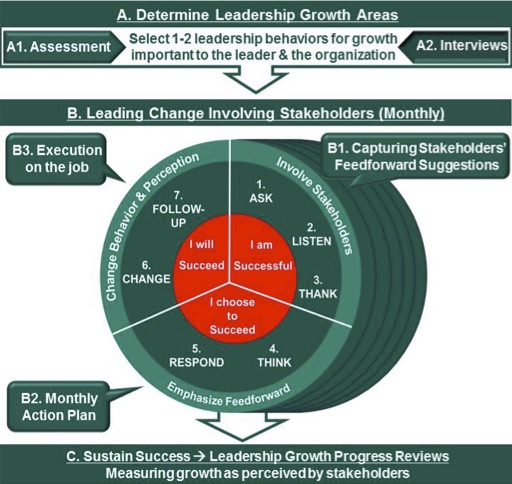Marshall’s highly successful approach to executive development and coaching includes a strong emphasis on the involvement of stakeholders, implementation of change, and follow-through to measure growth in leadership effectiveness.
In the end, the only thing that counts is leadership growth i.e., leadership (behavior) effectiveness on the job as perceived by stakeholders.
As Marshall puts it: “Leadership Change and Coaching are simple but not easy!”
Stakeholder Centered Coaching developed by Marshall Goldsmith is a highly effective, transparent, structured, and time-efficient process that works as follows:

A. Determine 1-2 Leadership Growth Areas Important to the Leader and the Organization
In consultation with the coach, the leader selects 1-2 specific behaviors that are important for his/her leadership growth (e.g., empowerment and decision making). Behavioral interviews and multi-rater leadership assessments (180° – 360°) are used to determine the aforementioned focus.
B. Leading Change Involving Stakeholders
The leader selects a handful of stakeholders, mostly the boss(es), direct reports, and peers. Throughout the coaching program, the leader involves these stakeholders monthly in the leadership growth process, creating accountability for the leader in implementing the change, as well as for the stakeholders to support and take part in the change process. This impacts and benefits the leader’s team as a whole.
B1. Involve Stakeholders to Capture Feedforward Suggestion
Every month the leader asks stakeholders to provide a few practical feedforward suggestions as it relates to his/her leadership growth areas.
B2. Stakeholder-Based Monthly Action Planning
The leader thinks through the feedforward suggestions from the stakeholders and drafts a monthly action plan. During the coaching session, the leaders work on skill development and finalize an action plan which the leader is committed to executing during the next month. After the coaching session, the leader responds to the stakeholders, informing them about his/her action plan.
B3. Change Behavior and Perception through Execution on the Job
Throughout the month, the leader implements his/her action plan and demonstrates to the stakeholders through his/her actions that (s)he is working to make change visible and become a more effective leader in the two selected leadership growth areas. Implementing change and following up with stakeholders also alters the stakeholders’ perceptions of the leader over time.
C. Perception is Reality: Measure Leadership Growth based on Stakeholders’ Perception
The coach checks in with the stakeholders approximately every quarter via a short internet-based survey, to measure the stakeholders’ perceptions on how they see the leader’s effectiveness has been changing in the two leadership growth areas. This Leadership Growth Progress Review is reported back to the leader (and the sponsor) so that (s)he can gauge how the stakeholders have perceived his/her leadership change efforts. This survey also plays a crucial role in guaranteeing and measuring leadership growth for the leader and the organization.
Like to discuss further or ready for action? Feel free to schedule a call straight into the agenda of Sandra Geelink.
